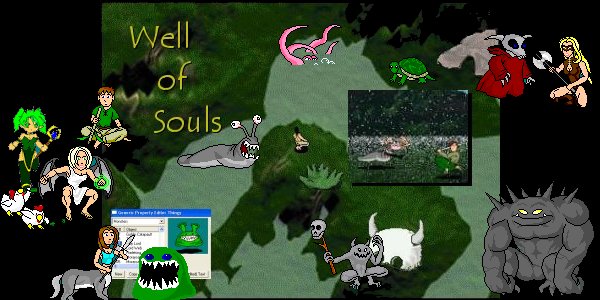The Well of Souls core tends to get described as a game engine more than anything else, with user-created "worlds" being the games themselves. Each world has its own story, artwork, music, etc and are completely independent of each other. This means you cannot create a character in the world called RoT and expect to be able to use it in Specops. You must create new characters, starting at level one, before playing each world.
Due to the variety of worlds, with each of them being different and of better quality than others, it's difficult to review Well of Souls based on traditional categories such as "graphics" and "story." It's definitely no graphical powerhouse, only supporting 2d images with a fairly small color palette at low resolutions. Regardless, good artists can make and have made good looking worlds.

Other than worlds, there is another unique feature of the game: cheats. What game on earth would willingly allow players to cheat? Why, Well of Souls of course. Players can enter "cheat codes" that will do certain things, such as resurrecting themselves. This can become a nuisance at times if another player wants to fight a cheater, but any player is able to host a server and set the rules to disallow cheaters from joining. Cheaters are also easily marked for other players to see.
Now, what kind of MMORPG would this be if it didn't have a clan function? Clans in Well of Souls are called Guilds, and they can be made across all worlds, and it's possible to have one guild take on characters from all worlds. Each guild gets its own page in the guild hall, where the details of each member are listed (world, level, class, etc) including the rank given to them by the founder, the Guildmeister. The Guildmeister is allowed to change the page background and music, and enter the guild's forum url amongst other small things.
A guild war system is supported, but it is incredibly flawed and rarely used. The basic concept is that one guild declares war one another a few rungs above them on the Guild Ladder. The guild goes out and fights members from the other guild to build up points. If they have more points when the timer hits zero, they win the war and rise above them on the ladder. The problem with this system is that fighting members of the other guild isn't the only way to build up points; killing monsters will also earn the guild points. The majority of wars using this system turn into mind-numbingly boring monsters slayfests. Guilds rarely use this system, and instead choose to simply ignore it, and still fight members of a guild they're at war with.
Well of Souls can be downloaded from here. Only one world comes with the game, the demo world called Evergreen. Other worlds can be downloaded separately by clicking "Check Online for New Worlds" in-game. If you're a socialite or a would-be game developer that doesn't the absence of polygons, Well of Souls is worth a try.


